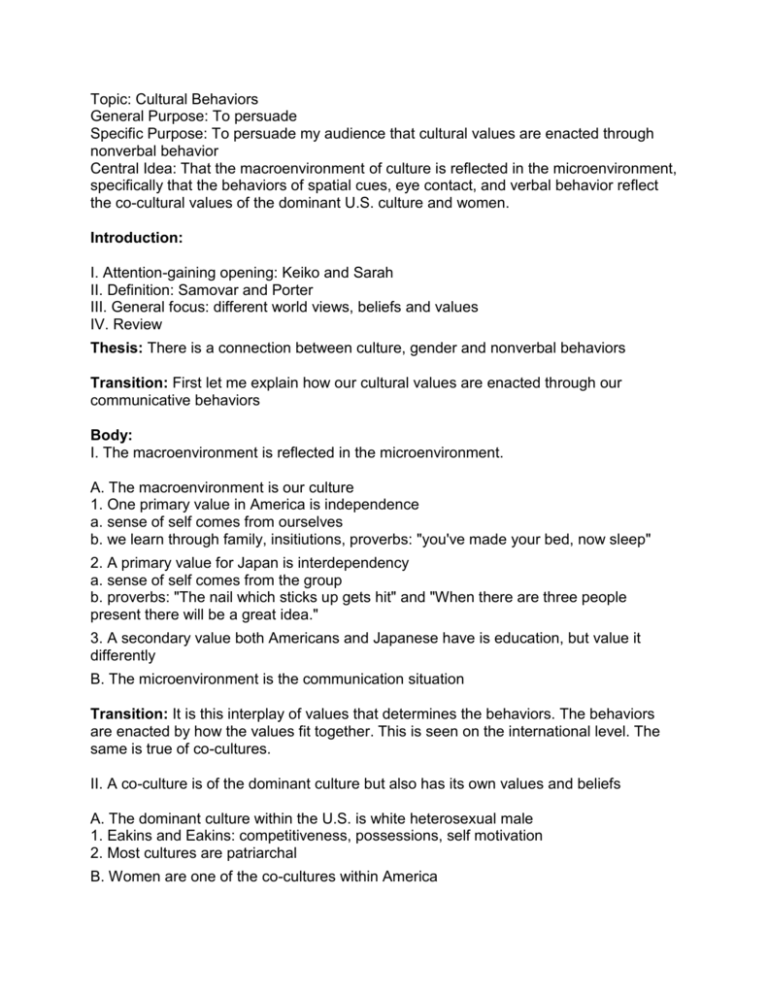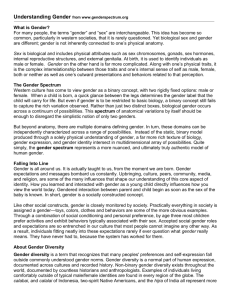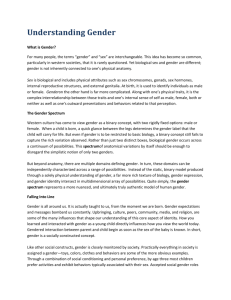Topic: Cultural Behaviors General Purpose: To persuade Specific
advertisement

Topic: Cultural Behaviors General Purpose: To persuade Specific Purpose: To persuade my audience that cultural values are enacted through nonverbal behavior Central Idea: That the macroenvironment of culture is reflected in the microenvironment, specifically that the behaviors of spatial cues, eye contact, and verbal behavior reflect the co-cultural values of the dominant U.S. culture and women. Introduction: I. Attention-gaining opening: Keiko and Sarah II. Definition: Samovar and Porter III. General focus: different world views, beliefs and values IV. Review Thesis: There is a connection between culture, gender and nonverbal behaviors Transition: First let me explain how our cultural values are enacted through our communicative behaviors Body: I. The macroenvironment is reflected in the microenvironment. A. The macroenvironment is our culture 1. One primary value in America is independence a. sense of self comes from ourselves b. we learn through family, insitiutions, proverbs: "you've made your bed, now sleep" 2. A primary value for Japan is interdependency a. sense of self comes from the group b. proverbs: "The nail which sticks up gets hit" and "When there are three people present there will be a great idea." 3. A secondary value both Americans and Japanese have is education, but value it differently B. The microenvironment is the communication situation Transition: It is this interplay of values that determines the behaviors. The behaviors are enacted by how the values fit together. This is seen on the international level. The same is true of co-cultures. II. A co-culture is of the dominant culture but also has its own values and beliefs A. The dominant culture within the U.S. is white heterosexual male 1. Eakins and Eakins: competitiveness, possessions, self motivation 2. Most cultures are patriarchal B. Women are one of the co-cultures within America 1. Relationally oriented, cooperation, other-interested 2. The Netherlands and Sweden matriarchal Transition: When you blend the dominant culture with the co-culture, you get a surprising array of interactive behaviors. III. While cultural values are reflected in all interactions, there are differences during interactions between males and females-blends of both A. This is seen in spatial cues 1. Males expand into available space a. taking more space b. using more gestures c. holding arms away 2. Females contract into smallest space a. taking less space b. using less gestures c. holding arms inward 3. When males and females interact, the females respond according to their partner and males are responded to B. Eye behavior also shows these differences 1. Males tend to control their partners' eye behavior: competitive (dog) a. look away while talking b. look away while listening 2. Females tend to gain relational information a. look more while talking b. look more while listening 3. When they interact, the dominance of the male is seen during the interaction, with the female responding, the male being responded to C. Besides this, our language is completely different 1. Males use competitive language 2. Females use cooperative language 3. When interact with each other, males believe females have the advantage Internal Summary: As you can see, each culture's value system is reflected through their behaviors. And the whole time we are assuming the other's behavior is the same as ours. Is it any wonder we are constantly saying, "I just don't understand (men!) (women!)!" And even if we think we understand that behaviors are different, we still don't get it. Transition: Part of this is due to the fact that not everything is different. IV. There are similarities also A. Both males and females share many nonverbal behaviors B. Both American and Japanese share many nonverbal behaviors (Review) So you can see, it is often the assumption that all communicative behaviors are the same, or are different, that creates misunderstandings. Conclusion: I. Review, summary II. Tolerance comes from realization of world view III. General intercultural process IV. Keiko and Sarah










